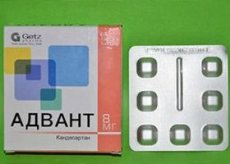Medical expert of the article
New publications
Preparations
Advant
Last reviewed: 03.07.2025

All iLive content is medically reviewed or fact checked to ensure as much factual accuracy as possible.
We have strict sourcing guidelines and only link to reputable media sites, academic research institutions and, whenever possible, medically peer reviewed studies. Note that the numbers in parentheses ([1], [2], etc.) are clickable links to these studies.
If you feel that any of our content is inaccurate, out-of-date, or otherwise questionable, please select it and press Ctrl + Enter.

Advant is a drug from a group of medicines used to regulate blood pressure levels and is an angiotensin II antagonist.
Other trade names: Candesartan, Candesartan-Lugal, Candensar, Kasark, Atakand, Khizart. International nonproprietary name: Candesartan. Manufacturer: Getz Pharma Limited (Pakistan).
Indications Advanta
This drug is intended for the treatment of arterial hypertension. Advant can also be used in the complex therapy of chronic heart failure associated with systolic dysfunction of the left ventricle, leading to secondary pulmonary venous hypertension.
 [ 1 ]
[ 1 ]
Release form
The drug is available in the form of square white tablets of 8 and 16 mg.
 [ 2 ]
[ 2 ]
Pharmacodynamics
When entering the body, candesartan cilexetil, which is part of the drug Advant, is converted in the intestine into active candesartan, which affects the renin-angiotensin-aldosterone system, which regulates the volume of circulating blood in the body and blood pressure. Advant selectively blocks angiotensin receptors (AT1 receptors) of smooth muscle cells in the walls of blood vessels.
These receptors stop perceiving the hormone angiotensin II, which ensures the process of vasodilation - the expansion and constriction of blood vessels - and participates in the formation of arterial hypertension syndrome and cardiovascular pathologies. In addition, angiotensin II stimulates the synthesis of the adrenal cortex hormone aldosterone, which regulates water-salt metabolism (the content of Na+ and K+ ions in the blood and the excretion of potassium by the kidneys) and hemodynamics.
Thus, a decrease in the activity of AT1 receptors leads to a decrease in total peripheral vascular resistance, which determines the antihypertensive effect of Advant, which is expressed in the normalization of blood pressure readings within 24-36 hours.
Pharmacokinetics
After oral administration, Advant is absorbed in the gastrointestinal tract and enters the blood. More than 99% of the active substance binds to plasma proteins, the maximum concentration in plasma is observed on average after 3.5 hours.
Absolute bioavailability of the drug is 15%; the half-life is about 9 hours; 90% of the dose is eliminated from the body after three days.
No more than 30% of the drug undergoes transformation in liver cells, the metabolites formed are pharmacologically passive. Advant does not accumulate in the body. A third of the drug is eliminated by the kidneys with urine, the rest (in unchanged form) - with feces.
Dosing and administration
Use Advanta during pregnancy
The use of Advant during pregnancy and lactation is contraindicated.
Contraindications
Contraindications to the use of Advant are:
- hypersensitivity to candesartan or other substances included in the drug;
- Conn's syndrome (primary hyperaldosteronism) - increased levels of synthesis of the adrenal cortex hormone aldosterone;
- severe forms of liver dysfunction;
- cholestatic syndrome (decrease or cessation of bile secretion or its stagnation in the liver).
It is not recommended for children and adolescents under 18 years of age to use this drug.
Side effects Advanta
Side effects of the drug include headaches and dizziness, muscle and joint pain, nausea, urticaria and itching, manifestations of asthenic syndrome, increased heart rate, hyperhidrosis (increased sweating), increased levels of potassium, calcium and sodium in the blood serum, functional disorders of the liver and kidneys, increased levels of uric acid in the blood, agranulocytosis, neutropenia or leukopenia.
While taking Advant, you should be careful when driving a vehicle, as the drug can cause attacks of weakness and dizziness.
Overdose
In case of an overdose of Advant, a drop in blood pressure to the development of orthostatic hypotension, dizziness and an increase in heart rate from 90 beats per minute may be observed. Treatment of overdose is aimed at restoring and maintaining normal functioning of the cardiovascular system.
Interactions with other drugs
Pharmacological interaction of Advant with antihypertensive drugs of other groups, as well as with diuretics, leads to an increased effect of lowering blood pressure.
Candesartan increases the concentration of lithium in the blood serum and increases the risk of developing toxic reactions.
When taking Advant and lilium preparations simultaneously, the lithium content in the blood serum increases, which leads to toxic reactions.
The use of Advant in combination with angiotensin-converting enzyme (ACE) inhibitors - Enalopril, Vazotec, Benazepril, Mavik, etc. - the risk of developing side effects increases significantly, especially renal dysfunction and hyperkalemia.
Storage conditions
Storage conditions for Advant: in a place protected from light, at a temperature not exceeding +25-27°C.
Shelf life
The shelf life of the drug is 3 years.
 [ 23 ]
[ 23 ]
Attention!
To simplify the perception of information, this instruction for use of the drug "Advant" translated and presented in a special form on the basis of the official instructions for medical use of the drug. Before use read the annotation that came directly to medicines.
Description provided for informational purposes and is not a guide to self-healing. The need for this drug, the purpose of the treatment regimen, methods and dose of the drug is determined solely by the attending physician. Self-medication is dangerous for your health.

